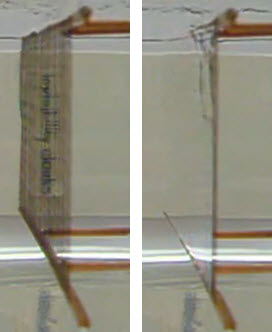‘Mirage effect’ helps researchers hide objects
October 5, 2011

Mirage effect: on and off (credit: University of Dallas)
University of Dallas scientists have created a working cloaking device using sheets of carbon nanotubes (CNTs), with a unique on/off switch.
The device uses the ability of CNTs to conduct heat and transfer it to surrounding areas to create the “mirage effect” that is observed in deserts or on long roads in the summer, an optical phenomenon in which light rays are bent to produce a displaced image of distant objects or the sky. In the device, a steep temperature gradient causes light rays to bend away from the object concealed behind the device, making it appear invisible.
With this method, it is more practical to demonstrate cloaking underwater because all of the apparatus can be contained in a petri dish. According to UT scientist Dr Ali Aliev, “Using these nanotube sheets, concealment can be realized over the entire optical range and rapidly turned on and off at will, using either electrical heating or a pulse of electromagnetic radiation.
“The research results also provide useful insights into the optimization of nanotube sheets as thermoacoustic projectors for loudspeaker and sonar applications, where sound is produced by heating using an alternating electrical current.”
Ref.: Ali E Aliev, Yuri N Gartstein, and Ray H Baughman, Mirage effect from thermally modulated transparent carbon nanotube sheets, Nanotechnology, 2011; [DOI:10.1088/0957-4484/22/43/435704]